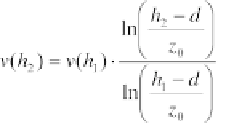Environmental Engineering Reference
In-Depth Information
Substituting
a
in the Weibull distribution and using
k
= 2 results in the
Rayleigh distribution
:
(5.5)
The Rayleigh distribution needs only the average wind speed as a parameter.
Figure 5.2 shows Rayleigh distributions for different mean wind speeds.
Influence of surroundings and height
The wind speed is usually recorded at a height of 10 m. Changes in elevation
can change the wind speed in a distance of only a few hundred meters. Hills or
mountains influence the wind speed significantly. On top of a mountain or on
the luff side, which is perpendicular to the wind (see Figure 5.3), the wind
speed can rise to become double the uninfluenced value. In contrast, the wind
speed is much lower on the lee side.
Obstacles, plants or hills near a wind generator site can slow the wind
significantly. Single obstacles are no problem if the total rotor area is over three
times higher than the obstacle or if there is sufficient distance between the
wind generator and the obstacle. However, this distance can be up to 35 times
the obstacle height. Without proper clearance, wind turbulence can reduce the
usable wind energy.
The wind speed increases with the height from ground because the wind is
slowed down by the roughness of the ground. Wind generators usually have
hub heights of more than 10 metres. For the estimation of the wind potential,
additional wind speed measurements at other heights are necessary. However,
if the type of ground cover is known, the wind speed at other heights can be
calculated.
The wind speed
v
(
h
2
) at height
h
2
can be calculated directly with the
roughness length
,
z
0
of the ground cover and the wind speed
v
(
h
1
) at height
h
1
:
(5.6)
Figure 5.3
Common Expressions for the Description of the
Direction of the Wind



